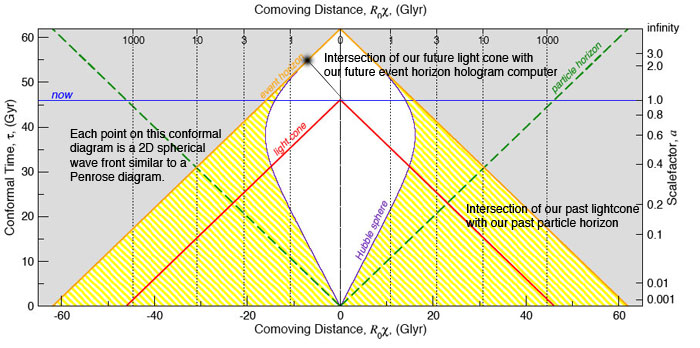c^2/rs + c^2rs/2r^2 in the Newtonian coefficient
in these units rs = 2m
Actually this is important, without these extra terms (i.e. c^2/\^1/2) the Hawking-Gibbons paper does not work.
However, for a black hole, I don't think the c^2/rs Hawking surface gravity term is there in the far field r ---> infinity unlike the Hawking-Gibbons effect since /\ is everywhere-when. So those guys who say the Unruh radiation is a misconception are correct!
On Jan 31, 2011, at 2:02 PM, Paul Zielinski wrote:
On Sun, Jan 30, 2011 at 10:43 PM, JACK SARFATTI <
On Jan 30, 2011, at 8:32 PM, Paul Zielinski wrote:
Of course the Unruh phenomenon depends on the acceleration of the detector. The question is
whether such effects are objective and can be thus separated from frame artifacts.
The effect is objective.
OK.
In my model, which may not work BTW, the virtual electron-positron pair is the accelerating detector because its stuck at the event horizon, whether objective or observer-dependent won't matter.
You said it was "clamped at the event horizon".
Yes, that's my key idea. The virtual photons in the vacuum at g00 = 0 must accelerate in the local curvature field in order to hover at fixed r.
OK that makes sense. Here physical acceleration is acceleration relative to the relevant geodesics of the gravitational vacuum, as usual.
Yes.
Even without Gibbons & Hawking, cosmological horizons depend on the position of the observer.
So?
So even without G&H cosmological horizons are already observer dependent. So the G&H proposal is not such a big leap.
The black hole horizon is not observer-dependent in the same way that the cosmological de Sitter horizon is.
I'm arguing your side now!
In the de Sitter observer-dependent case the photon emitted from the observer
From the physical detector?
Try to be clear, use "past emitter" and "future absorber" on our future light cone for a Cramer transaction.


who is always at r = 0 when g00 = 1 - /\r^2 sees a stuck e+-e- pair (static LNIF) at distance H from its (the photon's) horizon.
And this is not a virtual pair? We are talking about actual particles?
Yes and yes - it's a self-consistent process. Starts as a virtual pair pulled into a real pair.
The accelerating static LNIF virtual pair is clamped at the horizon. It is the future absorber (at r = /\^-1/2) when either its acceleration Unruh temperature T > 2mc^2 pulls that virtual pair out of the vacuum to a real pair, or the photon blue shift (emitted at r = 0) itself that the accelerating virtual pair sees > 2mc^2.
In the de Sitter case
[c^2(/\^1/2 + /\r^2) (1 - /\r^2)^-1/2)e1
note that the /\^1/2 term is like the hf/2 zero point term in the quantum oscillator - call it the horizon surface gravity Hawking radiation term missing from Einstein's classical calculation.
Or at least an analog thereof.
Is there a far-field Hawking radiation term for a black hole?
c^2/rs + c^2rs/2r^2 in the Newtonian coefficient
in these units rs = 2m
Actually this is important, without these extra terms the Hawking-Gibbons paper does not work.
However, I don't think the c^2/rs Hawking surface gravity term is there in the far field r ---> infinity unlike the Hawking-Gibbons effect since /\ is everywhere-when. So those guys who say the Unruh radiation is a misconception are correct!
